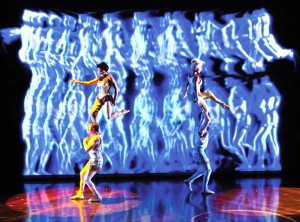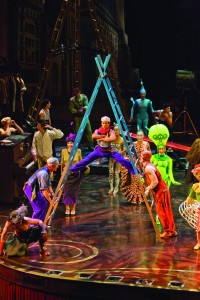Innovative production interprets evolution of cinema
Lights, cameras and action enthrall the audience in Cirque du Soleil’s latest innovative production, Iris: A Journey Through the World of Cinema. In its return to Los Angeles, where Cirque du Soleil first earned critical acclaim, this impressive $100-million production debuted Sunday at the Kodak Theatre in Hollywood.

Inventive acrobats · Cirque du Soleil merges the worlds of acrobatics, cinema and theater in its newest production, Iris, using tantalizing multimedia displays, such as rear-screen projections. - Photo courtesy of Cirque du Soleil
Iris (“eee-rees”) takes the audience on a historical trip of cinema, all the while combining live performance and cinematography as it covers various cinematic genres and time periods, including sci-fi, western, noir and even their modern-day combinations; moreover, the performance revolves around a central love story, typical of any popular movie.
Director Philippe Decouflé’s sensational work moves the audience back and forth between laughing and gasping with breathtaking feats and humor by the cast of 72.
Characters interact with audience members as the latter file in to find their seats before the show. One girl in particular (Ekaterina Pirogovskaya) asks attendees to spin her skirt to get it to light up with moving images. Inspired by a dancer’s tutu, the skirt, designed by Philippe Guillotel, is called the Praxinoscope costume. The skirt is named after the animation device in which a band of images are placed inside a rotating cylinder spun by hand.
The costumes complement the dark carnival-like set designed by the creative mind of Jean Rabasse. On each side of the stage, a man with a monocle and top hat stares at the audience with his gaped mouth serving as a passageway. Atop the proscenium arch are the words “In Motion We Trust,” which set up the subject matter of the show.
The set appears to be typical of any live production — until Iris begins. Once the show starts, the worlds of acrobatics, cinema and theater merge. As twins Andrew Atherton and Kevin Atherton fly above the audience, the set turns into a screen projecting images of the acrobats. And throughout the remaining two and a half hours, the set is crucial for rear-screen projections and special effects.
The first half of the production is darker, with shadows on the set created by rear-screen projections, as the show delves into the world of black and white and animation. Unfortunately, the first half is also filled with weak jokes, like when one character says he is having a “Kodak moment” onstage.
During intermission, the show continues. Those who stay in their seats will be entertained by characters who reappear onstage. While some attendees take the opportunity to visit the restroom, various characters interact with audience members by making them laugh and dancing onstage.

Cinematic gymnasts · The stage and characters in Iris emulate the evolving trends in film, starting with black and white and moving into the world of color — with the second act — giving the play a feeling of gradual development. - Photo courtesy of Cirque du Soleil
Though the first half fails in its attempts at comedy, it makes up for this by awing audiences with incredible acrobatic feats and the second half’s genuine humor. In contrast to the first half, the second half turns into a livelier, more colorful stage. It transforms into a behind-the-scenes set of a movie and later transitions into an award show. In this scene, everyone, from the audience to the orchestra players in the box seats, becomes a part of the performance. The audience erupts in laughter, unlike the forced laughter from the first half.
An audience member is randomly selected as an award nominee and taken to the stage to accept the award, but another nominee interrupts his acceptance and challenges him to a contest. The success of the segment depends on the audience member at hand, in which case the characters run the risk of not picking out the most enthusiastic audience member. The act does indeed serve as one of the highlights of the show because of the audience interactivity and the jabs at the drama found in award shows.
Another minor hiccup of the show comes in the form of brightly colored acrobats in ant costumes who nearly fell while twirling and landing on their partner’s hands and feet, which contrasted with the perfectly in-sync performances by the other acrobats. And although the acrobatic numbers are breathtaking, a couple of them go on for a bit too long.
Nonetheless, Iris brings a different perspective to the world of cinema, adding elements not available to filmmakers, such as audience engagement and the possibility for error.
The show will run for an indefinite time at the Kodak Theatre for 11 months out of the year; February will hold no performances for preparation of the Academy Awards.
